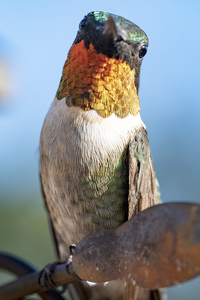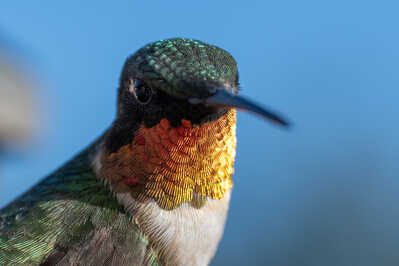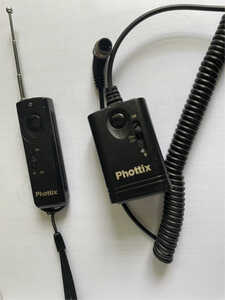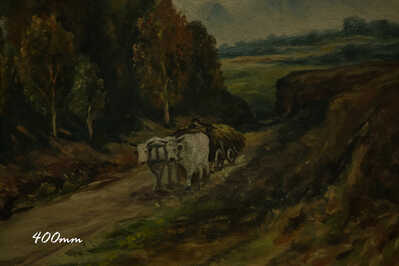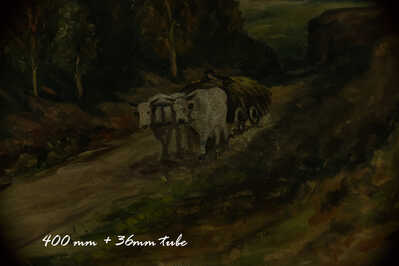I keep trying new things with my camera - a Nikon Z7ii. One feature I've used from time to time is Snap Bridge to do "remote photography". It works pretty well trying to take shots of the milky way, landscapes and anything else that is slow moving. Unfortunately I'm having more frustration using the same solution for fater moving wildlife - like this little humming bird. (I swear that little guy is saying "ha ha" in that photo!)
Here is my question: given the camera I'm using, what would others suggest I consider to have better control over the sutter.
The only limitation is I don't want a huge "kit". Right now I can keep most of what I need in a small(ish) backpack - including a few water bottles for my wife and I.
You've got a few options. You can go wired with a Nikon MC-DC2 or similar compatible third party remote release, or you can go wireless with the Nikon ML-L7 or a similar compatible third party remote.
In both cases it's small, but you'll want to pack more batteries since the camera likes to go to sleep quite quickly in photo mode and you'll want it to wait longer before doing so (at least for the wireless remote).
Looks like the ML-L7 uses bluetooth - that would be easy enough to setup... with the battery issues you note.
Question: any delay in the sutter release with the bluetooth option? I think SnapBridge is sluggish due to all the overhead of the app - hoping that is the case as that bluetooth option might be the way to go- thanks!
@kwongphotographyhotmail-com I'm still learning - not a pro. Just a nights and weekends photographer. Interesting suggestions to try!
I agree that the humming birds are pretty receptive to getting close - within limits. The Sigma 150-600 has been my go-to lens for most shots like this. However, that lens has limits with my goal to get even more detail. (And try new things. Or maybe I'm just wierd.)
Before buying an even longer lens, I'm trying a different route by stydying the creature habits, using the Nikon 105 MC Z mount and releaseing the shutter remotely. It actually works pretty well! The difficulty with Snap Bridge is you poke the little button on the app and a few seconds later the shutter releases - an eternity in humming bird years.
The post was to see what people might be using and your feedback actually helps confirm what I would like to purchase long term: Nikon Z 400mm f/2.8. But I'm only budgeted for the Nikon Z 180-600 I've had on order for months. That will replace the Sigma with (I'm hoping) a few more options - but I don't expect to be totally blown away as the Sigma is a pretty good lens.
Anyway, I'm trying the "zoom with my feet" option and hopefully add another set of tricks that might come in useful.
Good information!
Totally agreed on composition and details. (I beat myself up on composition all the time.)
I like your point that APS-C would be a good way to get the effect with less money. I'm also concerned about weight!
I did get a nice hand held shot of one of the humming birds with that 105mm. It is amazing how trusing they are (Hummer). Now the local fox i've been wanting a shot of ... still trying to figure out where and when to setup.
I'm within 10 years of retirement and the Z system is happening at a good time to build the glass I own. The 180-600 is a good fit for the backpack my wife and I take on hikes locally and when on vacation. The larger glass is a bit of a "maybe" right now - I'm in no hurry. For now I'm getting to know local photographers and reading more online - like this site - to learn more and just see where that leads me. Not 100% sure about focusing on bird photography. As one local photographer I talk to says, "I'm not taking picutures of birds, I'm taking picutres of sticks!"
I do have a question on the primes larger than 400mm though: is it hard to "aim" the lens? Or do you get used to it? The Sigma 150-600 allows me to "zoom to" the bird if in a tree and it seems having a long prime would make that rather challenging.
That's a great photo, @bhoward!
I find that up to about 800mm, it's easy to point at the right subject almost all the time with a prime lens. The exception is when the scene is pretty uniform, like a field with a lot of the same birds, and there's one particular bird you're trying to point at. Still doable, just harder. As soon as I add a 1.4x or especially 2x TC to an 800mm lens, it starts to be a much tougher process, at least for me. But the level of difficulty depends heavily upon how much variation there is in the scene.
Thanks for the feedback. (And all the good articles!)
Much to consider.
Very nice photos!
You did confirm with the post another question I did not know how to ask: minimum focusing distance. Basically how to get past the magnification ratio. Some of those long lenses will get you closer, but if the subject is a small bird you are again standing further away to satisfy the limits of the lens. I never knew (or thought) extension tubes would be used on a long lens. Interesting!
(I did rent a copy of the Z 100-400mm and that would be useful with the humming birds due to the close focusing distance. For some reason I just can't sell myself on that lens.)
That Phottix looks to be an interesting option- thanks!
About tubes
I used my Tamron 100-400 mm f/4.5-6.3 on my D850 with two tubes 12mm+20mm at the minimum distance(1.5 m) of the lens and 400 mm: for a sharp image, I got closer to the subject at about 90 cm
At 100mm with the same two tubes I got closer to the subject at about 30 cm.
As You can see the corners are dark.Images have not edited,only transfer from NEF to JEPG
Other mode to use tubes is to shot at another distance .I shot at 400 mm and about 2.5 m without tube and at the same distance with 36 mm tube.Images have not edited to see the influence of the tube on the exposure.Of course You will observe the same dark corners. The use of tubes means manual focus !
Success!!!!!
Question: what title should I look for from Mark Smith on Amazon? I see several that look interesting from that author on Amazaon.
I've done some macro (not a guru, I just like mushrooms, flowers and bugs) with the F mount Nikon 60mm lens. I've added the Z 105mm and have finally gotten used to the new lens and wondered if it would work with extension tubes - now that they are avaiable for the Z system. In short - I think extension tubes might be something to give a try - with something other than a macro lens!
Thanks again for the ideas and the wonderful examples!
For more responsive shutter control with your Nikon Z7II, especially for fast-moving subjects like hummingbirds, consider using a wireless remote such as the Nikon ML-L7 or a third-party Bluetooth remote for quicker response than SnapBridge. These are compact and won’t add much bulk to your kit. You might also explore interval shooting or the camera's built-in timer mode for timed captures. If you’re comfortable with a smartphone, the SnapBridge app can work, but there's often a slight lag which makes it tricky for wildlife. A small, dedicated remote offers better timing accuracy without increasing your gear load.
@etherarts - you are spot on!
After this post, I got the Godox TR-N1. There may be better options out there, but it is very responsive for fast wildlife yet has the ability to collect a lot of photos when the camera is mounted ot an astrotracker. As you noted - it really opened a lot of options!

